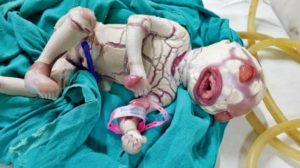“Push”
“Ahhhhhhhhh….ehnnnnnnnnn[the patient pushes with her might]”
“Push a little harder. You are doing so well”
“[She keeps pushing with everything in her]”
“Push harder. The baby’s coming out”
“ahnnnnnnnnnnnnnnnnn[ she uses all her strength to push]”
The baby comes out after trying for a few more seconds
“15:34”, the nurse starts to say. . ., but keeps quiet because she has seen something odd about the baby: his skin
Not to scare the baby’s mum, all the doctors and nurses try to act like nothing had happened
“15:34, a boy have been born to Mrs. Johnson” the patient suspects something strange from their tone of voice.
“Scissors” the baby’s umbilical cord is cut and the placenta is brought out
“Can I see my baby” Mrs. Johnson asks
“There is something we have to quickly check ma’am” one of them says because that is not the right time to show the child to its mother. It might just result into something else for her.
“Is my baby fine?”
“I think you should take a rest ma. As soon as possible, you will see your child”
Outside the delivery room, everyone is discussing what they just saw
“I have only seen this situation in books. This is the first time I am seeing it in real life. So this condition is really true” Nurse A says
“I have not even seen it before. I wonder the patient’s reaction when she sees her child” another nurse says
Meanwhile, as conversations like this continue, the baby has been taken for intensive care as soon as possible to avoid infections.
“Doctor B, why is everyone talking in different groups? Is there a problem?” doctor A asks
“That is because a baby with a bad condition has just been delivered”
“Oh! Bad news. How bad is it? Is the mother aware yet?”
“She is not. The shock will be too much for her now. We will wait for a few days, or ask for her husband’s opinion after showing the baby to him”
“I take it that the husband does not know yet”
“No he doesn’t. The only thing he knows is that the baby is a boy, and that his wife alongside the baby are fine. We should tell him soon”
“By the way, is it down syndrome?”
“No, it is a very severe case of harlequin ichthyosis”
Harlequin ichthyosis, also called Harlequin baby syndrome is one of many types of ichthyosis. It is a condition that involves the skin. It means persistently widespread thick dry, fish-scaly skin all over the body. What this implies is that the skin looks like scales of fish. Unlike other types of ichthyosis like ichthyosis vulgaris, this is severe and requires intensive care at birth. As at 2019, one in three hundred thousand babies are born with it. Most babies with this condition are born prematurely and because of complications may have to be born through caesarean section. Others though are born using natural vagina delivery. Because the thick scales they have, their skin is hardened. It becomes difficult to breathe and eat. Their skin cracks and split open which exposes them to infection and germs.
Because of their fish-like scales, thick, yellow skin, and other conditions that might result are: eyes not closing, lips pulled tight, ears fused to the head, dehydration, inability to hear well, irregular temperature, and high risk to infections. The disorder affects the shape of organs in their body. All these is because of the abnormal process their skin undergoes. Instead of their dead skin cells to be shed from the top layer of the skin at the same time that new skin cells are formed in the deepest layers of the skin, the dead cells in their case are either shed too slowly, or the production of new cells from the lower layers is too slow. This results in loss of water from the skin.
This syndrome is passed through autosomal recessive genes. Mutations in the ABCA12 gene causes harlequin ichthyosis. If one carries the gene and gets married to someone carrying the gene, there is a possibility that a child from the union has harlequin baby syndrome. It is also important to know that apart from being hereditary, even if one’s parents do not carry the gene, it is possible that it occurs spontaneously. Harlequin ichthyosis is not the fault of the mother. If a child was going to have it, there is nothing the mother could have done to prevent or cause it.
Before pregnancy, to check if there is a family history, genetic testing can be done before pregnancy by one and the partner. During pregnancy, prenatal testing can be done with the samples of the skin and blood of the prospective parents.
When a child with harlequin ichthyosis is born, it is usually recognized during birth by appearance but testing is also done to confirm the syndrome. There is no cure, a child has to live with it its whole life. Normally, for some other types of ichthyosis, someone born with it can live even up to his teens, and to adulthood. For Harquelin ichthyosis though, many children don’t live up to a month, some do not even survive weeks. For severe cases, the rate of survival for very severe cases is one in millions.
Because of improvement in healthcare system, many live up to a year and might live even more. Even though there is no cure to this condition, keeping the skin clean and moist to avoid cracking of the skin and continual monitoring helps to care for the child. Initial treatments almost as soon as the child is born such as applying retinoid to get rid of scale, redness and itches is good management for a baby with Harquelin ichthyosis.
The reaction of many to having a child with this condition is shocking. Many experience shock initially and accept what has happened to them. Others have been reported to have abandoned such children because of shock and because they do not want an ‘abnormal’ child. They forget that the situation is because of no one’s fault. They fail to care for the child as much as they can for as long as he/she lives. Many have become so psychologically affected that they need counselling and maybe therapy. Many, though, have accepted what has happened and taken steps to care for such children.
The bottom line is that no matter how difficult it is for parents with such children, it is important to always remember that harlequin ichthyosis is no one’s fault and children with it need as much love as they can get.
Writer: Stella Olanike Agboola
Obafemi Awolowo University, Ile-Ife, Osun State, Nigeria


Seriously!
Thanks for this.
There’s more to know about your partner apart from their genotype.
This is very informative, thanks to the writer .God bless you.
Wow wow wow!
I can’t imagine how parents of such children feel and what they go through psychologically.
Thanks for this knowledge u have impacted in us
We really need to undergo series of test before marriage
In this world ehn, no one is perfectly healthy
Going for DNA test is the surest thing to do before marriage 💯
This condition is one I wouldn’t even wish for my enemies. I know it would be very difficult living with a family member suffering from the condition as the person would ALWAYS need intensive care.
You are an excellent writer. Keep it up!